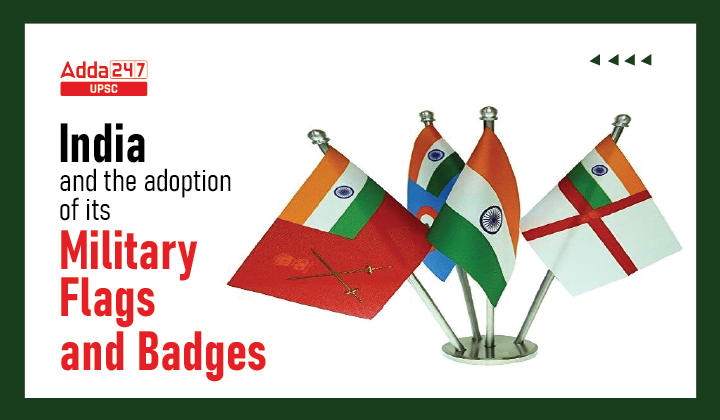Table of Contents
India and the adoption of its Military Flags and Badges- Relevance for UPSC Exam
General Studies I- Modern History.
In News
The new Naval Ensign (flag), which will be unveiled by PM in Kochi, has brought into focus the flags and ranks adopted by the Indian military after Independence.
- Documents accessed from National Archives of India show that Lord Mountbatten, former Viceroy and Governor General of India, played a major role in suggesting new flags and rank badges.
- This was when India was about to become a Republic on January 26, 1950.
Fact
The octagonal shape with twin golden borders draws inspiration from the seal of the great Indian emperor, Chhatrapati Shivaji Maharaj, whose visionary maritime outlook established a credible naval fleet
When did India switch from British-era flags and ranks?
- Prior to 26th Jan, 1950, the day when India became a Republic the flags and badges of ranks of the military were of the British pattern.
- The new, Indian pattern of flags of Army, Navy and Air Force, and also the Regimental Flags of the Army and badges of ranks of all three services were adopted on January 26, 1950.
- The ‘Kings Commission’ granted to Indian military officers was also changed to ‘Indian Commission’ on the same date.
- And at a subsequent date the King’s colours of the various Regiments were laid to rest in Indian Military Academy (IMA), Dehradun.
Lord Mountbatten and the National Archives
- The national archives have files, dated 1949, that include a detailed note from Lord Mountbatten regarding names, flags and ranks of the armed forces, and then PM Nehru’s letter to the then Defense Minister Baldev Singh regarding Mountbatten’s suggestions.
- The note, archives reveal, was given to Nehru by Lord Mountbatten when the two met in London.
- The note was forwarded from the PM’s office to the office of then Governor General C Rajagopalachari on May 24, 1949, stating that it is on the issue of ‘Names and Insignia of Indian Armed Forces’ after India becomes a Republic.
- The letter also stated that the note should be placed before the Governor General.
- The note begins by saying that consequent to becoming a Republic the word ‘Royal’ shall be dropped from India’s Army, Navy and Air Force.
- Mountbatten strongly recommended that no other word like ‘State’ of ‘Republican’ should replace the word ‘Royal’.
- This was because it would have the effect of separating the forces of India psychologically from the other services in the Commonwealth.
- He further suggested in the letter that the Crown should be replaced from the insignias and replaced by the “three lions of Ashoka”.
- Regarding the Naval Ensign, he said that all Commonwealth navies fly the same flag which consists of a large white flag with a red-cross and Union Jack in the upper corner nearer the staff and is known as the ‘White Ensign’.
- The new Ensign, the note suggested, should continue to have the red-cross but the Indian national flag should replace the Union Jack so that a commonality with the Commonwealth flags can
Changes for uniforms
- He strongly urged that existing uniforms should be changed as little as possible.
- He added that the Crown worn on badges of ranks of Majors and above should be replaced by the “three lions of Ashoka”.
- The Star of the Order of the Bath should be replaced by Star of India or another form of star.
- He also suggested that the crossed sword and baton on the badges of ranks of Generals should be retained.
- The former Viceroy advocated retaining the stripes of rank in Navy and Air Force saying these were internationally almost the same.
Indian government reaction to Mountbatten’s suggestions
- Nehru wrote to the then defence minister in September 1949 saying that he agreed with the suggestions made by the former Governor General that there should be as little change as possible.
- The then PM particularly mentioned the changes suggested by Mountbatten for the Navy.
- Then Governor General C Rajagopalachari also wrote back to Nehru in May 1949 itself agreeing to Mountbatten’s suggestions.
- In the end, Mountbatten’s suggestions were virtually all accepted and implemented with effect from January 26, 1950.




 TSPSC Group 1 Question Paper 2024, Downl...
TSPSC Group 1 Question Paper 2024, Downl...
 TSPSC Group 1 Answer key 2024 Out, Downl...
TSPSC Group 1 Answer key 2024 Out, Downl...
 UPSC Prelims 2024 Question Paper, Downlo...
UPSC Prelims 2024 Question Paper, Downlo...
